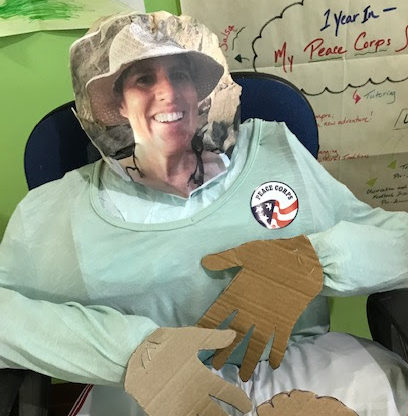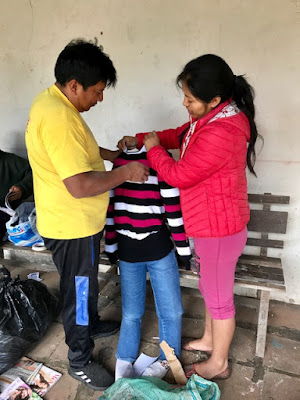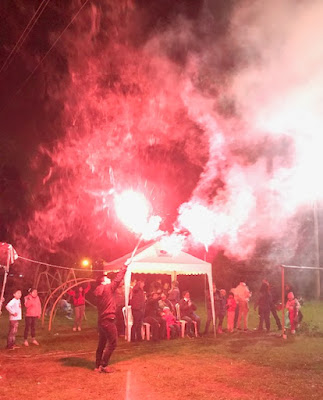The turning of the calendar to a new year is celebrated around the world, and South America is no exception. Here in Ecuador, this favorite holiday is called Año Viejo, or “Old Year”, and it incorporates many traditions to send off the bad of the previous year while welcoming a new and positive year to come. Last year, I spent New Years traveling with friends to Riobamba, Ecuador (see post in January 2019), so this year, I wanted to stick close to home to learn more about my family’s celebrations.
First, since our local barrio was hosting their festival on Saturday, December 28th, Jose’s extended family decided to hold the Angamarca family party on the same day, just down the road at their parent’s farm. It was decided that we needed three turkeys, a bucket-full of potatoes, salad and lots of beer. Like any modern family, they coordinate all of this through texts. It’s also their tradition to have organized games to play and a ritual “monigote”, or puppet, to burn, in order to cast off the old year. They drew straws, and my Aunt Carmen became the lucky soul to get a monigote made in her likeness.
The morning of the party, Carmen’s daughter, Susy, and Jose’s brother, Sergio, volunteered to make the paper-stuffed monigote. To send off the negative energy for the old year, it’s important to use old clothes that the person has worn.
They spent a long time sculpting it and when they were finished, it looked like Carmen. Then, Jose and Margarita came along and added some notes or references to some bad or silly things that had happened to Carmen throughout the year. I watched this process carefully because I wanted to make a monigote of my own. More on that later.
That evening, after our wonderful dinner, Jose’s brother, Kennedy, got the party started
by reading a spoof of Carmen’s epitaph, while Carmen and Wilo
by reading a spoof of Carmen’s epitaph, while Carmen and Wilo
carried her off to the yard for the ritual burning.
Bad spirits of 2019, be gone!
Bad spirits of 2019, be gone!
We also played lots of silly games including musical chairs, and I won the Limbo Contest.
Then everyone at the party started to dance, and it was time to walk
down to the community party. We could already hear it in full force.
Right in the middle of the party, many Angamarca family members had to leave to attend
an award ceremony. Los Aguilas, the family Futból Club, had won another championship.
They returned with a tall trophy and we had more to celebrate! The band didn’t quit until
3am so we danced and laughed, and danced some more.
3am so we danced and laughed, and danced some more.
| Pausing for a picture: Sergio, Jose, Me, Margarita, Carmen, Johana and Susy |
My favorite part of these parties by far, is the people watching. A “jaba”, or crate of tall Pilsners, is the common gift to bring to the party. You carry it around, and with one plastic cup you drink and share. All night long. Until you need a nap. And then, you can just sit on your crate and close your eyes for awhile. When you wake up, the beer is still there for you to continue the fun.
On the December 31st, of course, the party continued. But in addition to music,
dancing and fireworks, there’s a lot of specific traditions which are important to follow
if you want to send off the bad, and invite in the good, for the new year.
First, it’s important to clean the house physically, and cleanse the house spiritually
with some incense. Margarita practically smoked us out with some Sandalwood.
| If you want to travel successfully in the new year, you need to run around your house three times with a piece of luggage like a backpack. Here is Pablo demonstrating how to do this. |
| Your color choice of underwear will also bring you fortune… either in love (red) or prosperity (yellow). I’m not going to tell you which color I chose to wear! |
| Additionally, you must plan ahead to eat 12 grapes exactly at midnight, one for each wish that will come true. Margarita packed a picnic snack of grapes for our midnight adventures. |
Next, you need to make, or buy, your own monigote to burn.
Large, fancy monigotes can cost $50-75 dollars.
Jose and Margarita opted for one of the plain stuffed dolls for $3.00 and then
they fitted it with a mask. At a local New Year’s Eve Carnival,
we had plenty to choose from.
we had plenty to choose from.
| We had fun trying on the masks, too. |
| Then, they attached it to the front grill of the truck, and we were ready to cruise the town. |
Fireworks are also available everywhere, but we opted to watch everyone else’s show, and didn’t buy any for ourselves.
Finally, we were ready to experience my favorite part of the Ecuadorian New Year- the Viudas Locas! These are young men dressed as women, who parade around in the streets stopping traffic and asking for beer money. Many of them look better in a dress than I do, and their dances get a little risqué as they pretend your car is a pole. It is hilarious! And of course you hand your change out your car window to encourage more of this behavior.
It’s all part of the fun!
After our wild ride through town, we finally got to a local party in time
to watch the monigotes burn and ring in the New Year.
to watch the monigotes burn and ring in the New Year.
After the celebration, there were games, a raffle and a dance party that promised to take us late into the next morning, but without me. I decided I had something else to do. I walked home in the rain and composed a letter to myself. Earlier in the day, I had scoured up some newspaper, cardboard and a stretched out shirt to make a monigote of my own. In this monigote, I placed a letter – a list- of all the complicated and compromised feelings I have been holding onto about me,
my past, my present and my future.
It was time to let them go…literally, up in smoke.
At 2 am on January 1st, 2020 I stood in the rain with a glass of wine
and watched the me of my past transform into cinders.
And with it, I said my goodbyes to a decade filled with pain and sorrow.
It was time to let it go.






